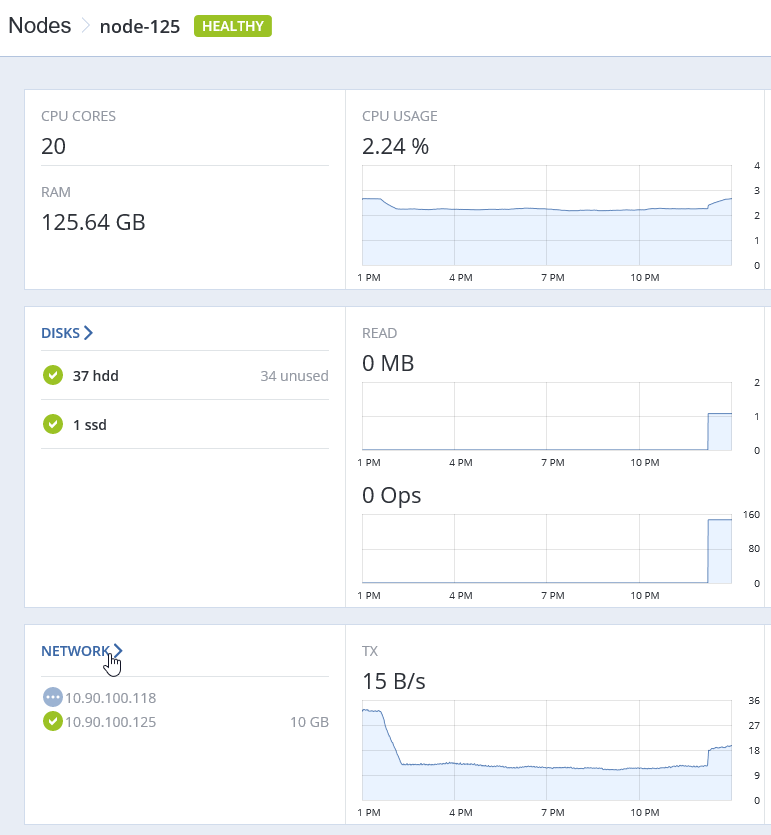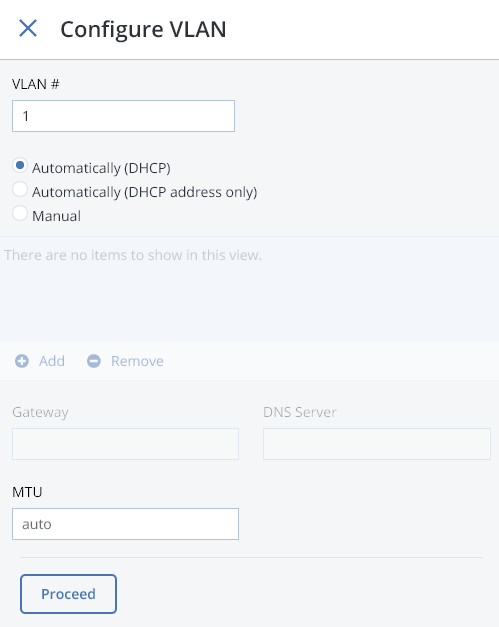2.1. Configuring Node Network Interfaces¶
As described in Planning Network in the Acronis Storage 2.0 Installation Guide, Acronis Storage requires one internal network for node traffic and one public network for exporting the storage space. You need to create these networks by assigning correct network roles to network interfaces on each node.
Important
To be able to create a cluster, you will need to assign a storage role to a node’s network interface.
To assign a network role to a network interface, do the following:
On the NODES screen, click the node to configure the network interface(s) of.

On the node overview screen, click NETWORK.

Select a network interface and click Configure.

On the Configure screen, do one of the following:
- To obtain the IP address, DNS, and routing settings from the DHCP server, select Automatically (DHCP).
- To obtain just the IP address from the DHCP server, select Automatically (DHCP address only).
- To specify the IP address manually, select Manual and add the IP address.
Warning
Dynamic IP address allocation will cause network issues as soon as the IP addresses of cluster nodes will change. Configure static IP addresses from the start or as soon as possible.

If necessary, set up a gateway and a DNS server.
If you have set a custom maximum transmission unit (MTU) on the network hardware, set the same value in the corresponding field.
Warning
Setting a custom MTU in management panel prior to configuring it on the network hardware will result in network failure on the node and require manual resetting. Setting an MTU that differs from the one configured on the network hardware may result in network outage or poor performance.
Click Done to return to the list of network interfaces, do not change the selection, and click Choose role.
On the Choose roles panel, select roles to assign to the network interface (for details, see Network Interface Roles in the Acronis Storage 2.0 Installation Guide).

If you need to open specific ports on a network interface with public roles, do the following:
Click Configure.

On the Configure custom role panel, create custom roles: click Add and specify role names and ports. Custom roles can later be assigned to any network interface in a cluster.
To remove a custom role, make sure it is not assigned to any interface, select it, and click Remove.
Click Done to return to the Choose roles panel.
- Select the required roles and click Done to assign them.
2.1.1. Setting Up Network Bonding¶
Bonding multiple network interfaces is optional but provides the following benefits:
- High network availability. If one of the interfaces fails, the traffic will be automatically routed through the working interface(s).
- Higher network performance. For example, two bonded Gigabit interfaces will deliver the throughput of about 1.7 Gbit/s or up to 200 MB/s. For a storage node, the required number of network interfaces to bond may depend on the number of disks. For example, an HDD can deliver data at speeds of up to 1 Gbps.
To create a bond, do the following:
On the NODES screen, click the node to bond the network interfaces on.
On the node overview screen, click NETWORK.
In the NETWORK list, check network interfaces to bond, and click Create bonding in the menu to the right.

On the Configure Bonding panel, select the bonding type from the drop-down list. The balance-xor type is selected by default and recommended for both fault tolerance and good performance.

Set up network parameters as described in step 4 in Configuring Node Network Interfaces and click PROCEED.
On the Choose roles panel, select roles to assign to the bonding network interface (for details, see Network Interface Roles in the Acronis Storage 2.0 Installation Guide).

Click Done.
2.1.2. Setting Up VLAN Interfaces¶
To set up a VLAN network interface, do the following:
On the NODES screen, click the node on which to configure VLAN.
On the node overview screen, click NETWORK.
Select a network interface and click Create VLAN.
On the Configure VLAN panel, specify a number for VLAN, add an IP address, and, if necessary, set up a gateway and a DNS server.

Click Proceed to create a VLAN interface.
